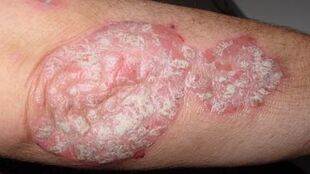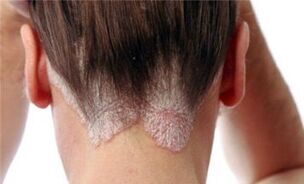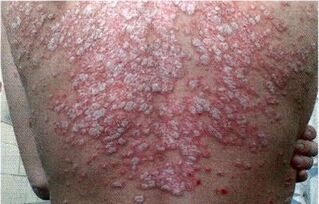
Psoriasis is a long-term chronic skin disease.
Causes of the disease
Psoriasis occurs due to the pathology of skin cells when the top layer of skin dies within 4-5 days, while this time interval is usually several weeks. The causes of the disease are not fully understood, but doctors identify a number of factors that provoke the disease:
- Hereditary predisposition - the disease occurs at a young age from 15 years and is more often inherited. If one parent has been diagnosed with psoriasis, the child has a more than 50% chance of getting the disease.
- Autoimmune conflict - with this type of disorder, the body’s immune cells stop recognizing skin cells as part of the body and begin to attack them as a foreign element.
- Nervous shocks - promote the release of hormones into the bloodstream, leading to metabolic disorders and provoking the development of the disease.
- Disruption of hormonal balance and metabolism.
Psoriasis is not contagious because there are no infectious agents that can be transmitted.
Symptoms of psoriasis
The main symptoms of the disease are characteristic skin rashes, which mainly affect the inner surface of the elbow and knee joints, as well as skin areas that often have frictional injuries.
Rash on the edge of the scalp and other less common localizations may also occur.
Skin rashes appear as patches of gray or white scales. Skin rashes in psoriasis have three characteristics:
- Stearin stain symptom:Whitish scales are easy to peel off, resembling candle wax powder in appearance.
- Terminal Film- After removing the scales, a whitish film is visible beneath the surface of the spot.
- Bleeding- when the stain is scratched, the end film is removed, the papillae of the skin are damaged and small blood droplets protrude.
In the early stage a faint rim is formed around the papule, at this stage no exfoliation occurs. Paleness around the spot is the body’s vascular reaction to the rejection of the epidermis. The disease is associated with severe itching of the skin, scratches and minor bleeding on the skin. A secondary infection can join, penetrating the damaged skin.
In addition to the skin, psoriasis also affects the nails, causing the nail plates to become brittle, have a transverse pattern and concave areas.
Autoimmune conflict can affect the joints and cause arthritic pain, especially in the finger joints.
Types of psoriasis
The first type of psoriasis occurs in people under the age of 30, it is an inherited disease that mainly affects the skin and has a typical localization.
TheII. This type of psoriasis affects people over the age of forty and is not inherited. It affects the nail plates and scalp more often, the rash is small and teardrop-shaped. The cause of the disease in elderly patients is a decrease in immunity in the background of chronic infectious diseases and improper lifestyle.
Clinical trials have confirmed the link between type 2 psoriasis and alcohol and the abuse of unhealthy foods.
Forms of psoriasis

Psoriasis has several forms of varying severity:
- Plaque psoriasis- characteristic papules develop on the skin, accompanied by itching and peeling. The
- pustular formis characterized by the appearance of bubbles, reddening of the skin around them, severe itching and burning is a moderate form of the disease.
- Erythrodermais characterized by massive skin lesions accompanied by outflow and discharge of large layers of the epidermis, particularly with difficult to tolerate, often accompanied by pustular lesions and fungal infections.
Stages of psoriasis
The disease develops in several stages:
- The initial stageindicates the development of the disease, during this period one, less often several pale spots appear, the skin begins to peel.
- The active stageis accompanied by severe symptoms, abundant discharge of the skin balance, itching and inflammation.
- Stationary phase- indicates remission, exfoliation practically stops at this stage, pigmentation or faint pseudoatrophy develops instead of a spot.
Diagnosis of psoriasis
You should consult a dermatologist to make a diagnosis. The pathology has a clear clinical picture, which is confirmed by the anamnesis and biopsy of the skin elements with subsequent examinations.
Psoriasis Treatment
Treatment of the disease should be approached comprehensively, while at the same time stopping external symptoms and influencing the possible cause of the disease.
Drug therapy
In severe cases, measures are taken to reduce the body's immune attack against its own cells:
- Cytostatics;
- antihistamines;
- corticosteroid hormones;
- Enterosorbents and hepatoprotectors are used to restore metabolism.
At the same time, measures are taken to saturate the body with the necessary vitamins and trace elements:
- Silicon is one of the important trace elements responsible for hormone balance and skin health.
- Calcium and vitamin D3 are needed for remission of the disease. It is prescribed together to increase the absorption of calcium.
Local remedies

To protect the skin, external agents are used in the form of ointments and creams:
- Glucocorticoids, which reduce the immune response, also reduce the symptoms of inflammation, relieving itching and swelling of the skin.
- Salicylic acid and plant products are essential for hydrating the skin and protecting against secondary infections.
- Local cytostatics are used only in the severe, active phase of the disease.
Procedures
Physiological procedures are prescribed to accelerate recovery:
- Cryotherapy;
- UV irradiation;
- Laser processing.
If necessary, plasmapheresis is performed to purify blood plasma and stabilize cells.
Prevention
If a predisposition to the disease is identified, a number of preventive measures must be taken:
- Live a healthy lifestyle, stop smoking and alcohol;
- Create a daily routine, avoid stress, take a reasonable approach to organizing your work schedule;
- Keep a diet, give up excessive amounts of carbohydrates, spices and fatty foods. Preservatives and instant foods should be avoided;
- Spend enough time outdoors;
- Use soap and shampoo with a specially selected pH, do not use a hard dishcloth and towel, dry the skin thoroughly after showering;
- Wear clothing made of natural material that is not too close to the body;
- Occasionally have a medical examination, check the levels of hormones in your blood, and start treatment early if necessary.
These measures help maintain healthy skin and significantly improve your quality of life.























